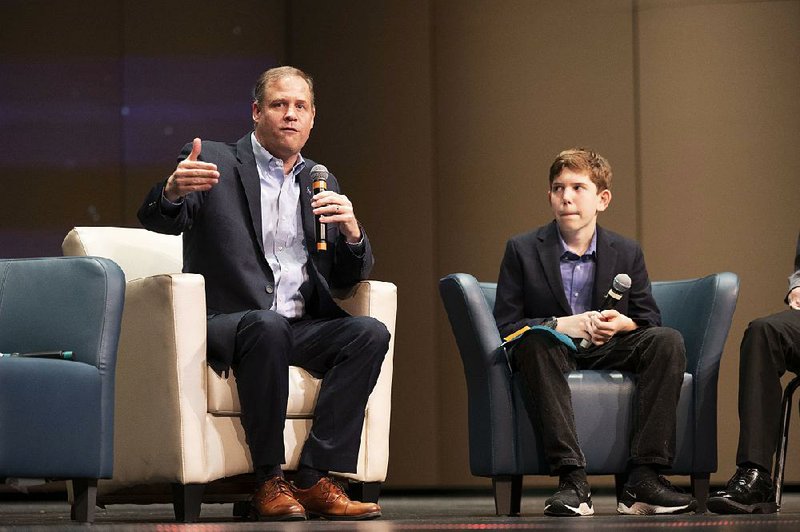FAYETTEVILLE -- The mission to have NASA astronauts again set foot on the moon within five years will serve as preparation for a journey to Mars, the space agency's administrator said Friday.
"The moon is the proving ground. Mars is the destination," Jim Bridenstine told students at the University of Arkansas, Fayetteville.
Bridenstine took on leadership of NASA in April of last year after serving from 2013-18 as a U.S. representative for Oklahoma, where he maintains a residence in Tulsa.
He visited Arkansas on Friday at the invitation of U.S. Rep. Steve Womack, a Republican from Rogers, and also spoke at a student event held at Bentonville High School.
The moon mission -- announced in March by Vice President Mike Pence as a 5-year goal to be achieved "by any means necessary" -- would provide another milestone moment for space exploration, Bridenstine said.
The mission, named Artemis, aims to land the first woman and the next man on the moon.
Bridenstine, 44, said he wasn't alive in 1972 for the last of the previous manned missions to the moon. The 1972 mission and the first lunar landing, which took place in 1969, were both NASA missions.
"We have had an entire generation go by -- my generation -- where we've lived our entire lives not having that moment where we remember exactly where we were when that stunning achievement happened," Bridenstine said.
At UA, Bridenstine visited with students in a classroom and students working in a laboratory that's part of the university's Center for Space and Planetary Sciences.
The center, established in 2000, had four students complete doctoral degrees and another earn a master's degree in the 2018-19 academic year, UA spokesman Nick DeMoss said in an email. The center's projects also involved 12 undergraduate researchers, DeMoss said.
"It was demonstrated to me that this is a talent developer for NASA," Bridenstine said, adding that some of the doctoral students already are working directly with the agency. "The University of Arkansas is doing great work developing that talent pool."
In a UA classroom, Bridenstine spoke about Mars and the need for further exploration.
He said the "building blocks for life exist on Mars," referring to discoveries made by robots sent to the planet and orbiting instrumentation.
"Am I saying that there's life on Mars? No, I'm not saying that. But there could be, and we need to go find out," Bridenstine said.
At an April budget hearing, some members of Congress took Bridenstine to task about the agency's spending plans. The $21 billion request increased in May to $22.6 billion after a budget amendment announced by President Donald Trump. Some expressed concerns that a focus on the moon comes at the expense of science and other agency programs.
Bridenstine called that a "false narrative."
"I want to be clear. My leadership, I am not advocating for a cut of one dime of the science mission directorate," Bridenstine said.
He said the "architecture" NASA aims to build for the moon would allow for people to live on the surface and in orbit.
In that case, "all of a sudden, we can do astrophysics missions for a fraction of the price," Bridenstine said, describing how building out the moon mission would also reduce the costs for other science work.
"The bottom line is we can do so much more when we start thinking of how we can work together rather than create these divisions of, 'Well, it's either human exploration or science.' That is a false narrative, and we need to kill it every chance we get," Bridenstine said.
Womack said "the most important thing" Bridenstine did during is visit Friday was to "engage with the next generation of scientists."
A goal for the visit was to showcase work done at UA, Womack said, adding that "it's important for Jim and the NASA folks to know what we have here."
UA System President Donald Bobbitt, who attended a portion of Bridenstine's visit, said NASA dollars also support "excellent" research at other campuses in the state. The state has two NASA-related programs: the Arkansas Space Grant Consortium, which has 17 member institutions; and NASA Established Program to Stimulate Competitive Research. They are both based at the University of Arkansas at Little Rock.
Metro on 11/09/2019
